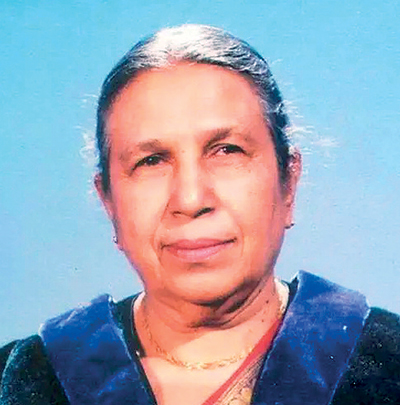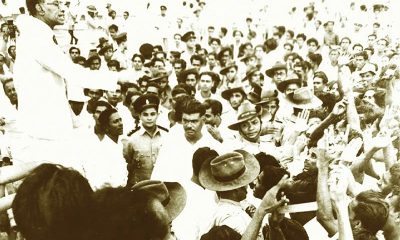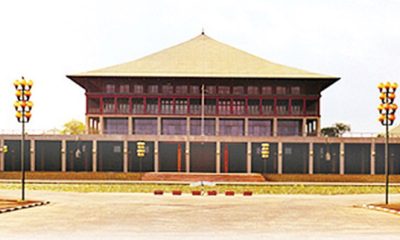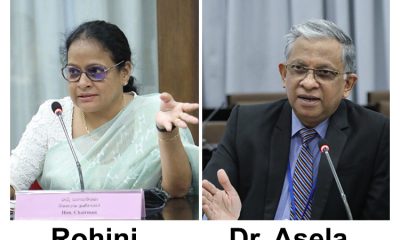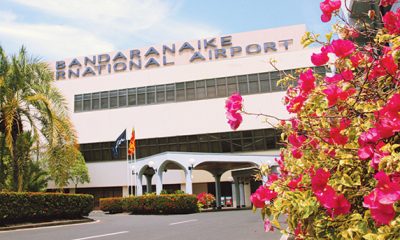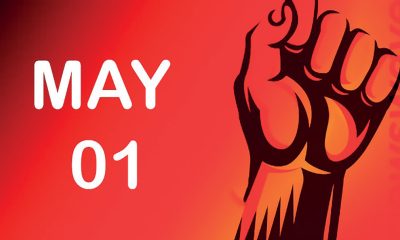Features
Formulating a National Policy on disability
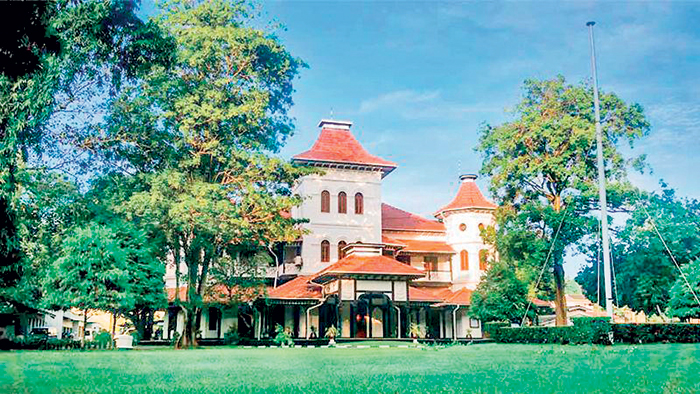
Disability studies in the universities
(Excerpted from Memories that linger – my journey in the world of disability by Padmani Mendis)
Prof. Chandra Gunawardene was the Dean of the Faculty of Education at the Open University of Sri Lanka, OUSL, at the turn of the century. I was recommended to her by her friend Prof. Swarna Wijetunge who had been a Professor of Education at the University of Colombo. Prof. Wijetunge was a member of the National Education Commission. She had always been sensitive to the poor quality of education available to disabled children. Prof. Gunawardene was keen to take action to uplift this through improvement in teacher education.
So she obtained the approval of the OUSL in 2004 to set up within the Open University a Department of Special Needs Education. She asked for my help to do this and had me recruited to the Faculty as a Senior Consultant. I set about getting the preliminary arrangements done. Meanwhile she also recruited to the Department of Special Needs Education two senior lecturers. She arranged for these two to proceed directly to the University of Lahore and return with their Doctoral Degrees to start academic activity in the Department. One of the first such activities was a Bachelor of Education Honours in Special Needs.
University of Colombo
The University of Colombo, since 2009 was running an “Ability Centre for Students with Disabilities”. It was helping students in a small way. Ashoka Weerawardena was running this centre.
Aloka Weerasekera had in 2012 obtained a degree from the Faculty. Aloka, as a student, had helped the Faculty and his disabled colleagues within it, to deal with the some of the problems they faced. And even after he graduated he continued to help Ashoka at the Ability Centre.
A new dean, Prof. Athula Ranasinghe, was appointed to the Faculty of Arts in 2011. He proposed that it was time that the Faculty demonstrated greater academic leadership in disability. Aloka and I were brought in to join the staff of the Department of Sociology on a planning committee to find a strategy for putting into practice this academic support for disability.
The end result of the planning committee’s deliberations was the setting up in 2014 of the Centre for Disability Research, Education and Practice popularly called CEDREP.
In the same year the US Embassy came in with a grant to finance improvements to the Ability Centre for the benefit of students. This Centre was upgraded and had its role and name changed to the “Support Centre for Students with Disabilities”. I was a frequent visitor to assist Ashoka with what I could. CEDREP called on me for advice in the early years when they needed it.
Disabled People to the Forefront
A significant outcome of CBR at the grass roots was the setting up of disability self-help groups. Fridsro helped in this in the government-supported CBR areas throughout the island. Unfortunately, government workers later made these into District Disability Organisations over which they could and did have influence. As was to be expected, the autonomy within the small self-groups was gone. Many disabled people who had been empowered through their self-help group were disillusioned and turned away.
Others, such as Nishar Sharif, persist even today, raising the issue of their rights and their inclusion within the district and province. Navajeevana encouraged the formation of self-help groups in the CBR areas they supported. These also developed into Divisional Disability Organisations. I have met some on my visits to the south. Although they are sustained with some financial support from Christoffel Blinden Mission, CBM, they maintain their autonomy and empowerment and participate in area development planning and activities.
In Sri Lanka there has not even until now been any kind of Disability Movement. In Colombo personable individuals set up organisations to publicise the needs of particular disability groups. Occasionally they would obtain sponsorship to implement interventions. Some have been led by disabled people themselves and others have not. There was debate about these at the time. Within the world of disability, it was felt that the organisation had to be managed by disabled people themselves to be recognised as a Disabled Peoples’ Organization (DPO). If it was managed by a non-disabled person or people, then it was thought of as an NGO.
S. L. Hettiarachchi
So the Sri Lanka Council for the Blind (SLCB) which was actually single-handedly run by S. L. Hettiarachchi, himself with visual impairment and totally unable to see, was considered to be an NGO. Its president, although only in a nominal role, was not disabled. Soon after I started working with the School of Social Work, I met Mr. Hettiarachchi. I used to meet him often thereafter for a chat in his office. We developed a close life-long friendship until he passed away in 2015.
With Mr. Hettiarachchi in the driving seat, the SLCB carried out many activities for young people – particularly, courses which imparted skills and knowledge scarce elsewhere such as in Mobility and Orientation and Information Technology. On a Saturday morning I would often drop in for a chat with the young people there.
What impressed me most was the Library the SLCB developed with an extensive collection of both written and audio publications made easily accessible to the many who availed of its resources. Mr. Hettiarachchi then extended the library to the thirteen Special Schools for the Blind located throughout the island and were registered with the Ministry of Education. He later sought and obtained support for this from Sight Savers International, SSI.
Three years later SSI requested me to evaluate the impact of their support to benefit children. One of the most interesting findings regarding project’s impact was the children’s increased love of reading. Many had become avid readers. Many had taken to reading a new book every two to three days. Many had shown improvement in language development, reading and writing skills, grammar, vocabulary and verbalisation. It strengthened my belief that it was the SLCB, as organisations were at the time, that had the greatest impact on disabled people.
Premadasa Dissanayake and Cyril Siriwardene
Another disabled person with whom I shared both a working relationship and friendship was Premadasa Dissanayake. Premadasa hailed from a village in Badulla in the Uva province. He came to Colombo as a wheel-chair user to seek employment. This he got at the Gangarama Temple in Colombo, first learning the skill of watch repair and then as a teacher of other young people both those who had disabilities and others who had not, to acquire the same skill.
He never forgot his roots and later, when he was able to implement field programmes, they were located around the village he came from. He impressed others with his honesty, diligence and hard work.
Premadasa was the core of the, Sri Lanka Foundation for Rehabilitation of the Disabled (SLFRD), which he established with support. Within this, he had soon set up a workshop to produce a range of appliances required by people with mobility impairments – wheelchairs, tricycles, crutches and so on. This workshop called Rehab Lanka bid for and obtained tenders for these and was a regular supplier to both the Ministry in Colombo and to Departments of Social Services in the provinces.
With funding from the Swedish Organisation of the Handicapped International Aid Foundation, he moved into community-based work. I enjoyed very much walking the villages in Badulla with his staff.
Such was the recognition Premadasa had that one of Sri Lanka’s leading garment manufacturers negotiated an agreement between Rehab Lanka and Marks and Spencer popularly known as M & S, the well-known chain of retail stores in the UK. Premadasa trained workers of the garment factory to produce the items they made for M & S. Training was done according to the technical and quality requirements as stated in the agreement between M & S and Rehab Lanka.
Working with Premadasa at Rehab Lanka was Cyril Siriwardene. Cyril had started using a wheelchair since he had met with a road traffic accident while serving in the Air Force. With his assertive but pleasant personality and skilled use of the English Language Cyril was soon recognised as a leader and disability spokesperson both by disabled people and by others.
It was Cyril, Premadasa and Mr. Hettiarachchi that established a dialogue with the Ministry of Social Welfare. This was the time that Viji Jegarasasingham (Mrs. J) had come to the Ministry as an Additional Secretary. She was open to it.
Ministry of Social Welfare
The Ministry of Social Welfare and disability groups soon had a regular conversation. An outcome of this was that in 1996 the first Disability Law was passed. This law was concerned mostly with the setting up of a National Council for Persons with Disabilities (NCPD), and with strengthening the provision of disability services within government. The NCPD was of course to be chaired by the Minister of Social Welfare.
As a positive step, the law ensured a majority participation of disabled people and their representatives in the NCPD, recognising their right to decision making in matters that affected them.
Recognising this in law but not, unfortunately, in practice. It is still the Ministry of Social Welfare that makes all decisions in the field of disability. Even in the making of a new law, a seemingly continuous process started in the year 2004 and is as yet incomplete.
I was not aware of the preparation or enactment of that law in 1996. Maybe I was too concerned with international work at that time. I served however on two consecutive National Councils, the first of which was set up as soon as the law came into effect in 1996.
My experience was that we did not really do anything to bring about changes in the lives of disabled persons and their families. Much of the monthly meetings dealt with acceding to requests by disability organisations and disabled people for financial assistance for a range of purposes from renovating buildings to organising sports events to staging concerts by disabled people.
Disability work was still very much based on charity. The disability representation at large on the National Council however appeared to be satisfied sitting with the minister every month and telling him of their woes. A vivid recollection I have of the first council is the minister, while sitting at the head of the long table, tucking in with satisfaction into a bowl of fruit salad. I must also say that to me he seemed not even to listen to what was being said.
- Prof. Chandra Gunawardene
- Prof. Athula Ranasinghe
National Policy on Disability
At the beginning of this decade there was some visible activity in the Ministry of Social Welfare as it concerned the world of disability. A newly introduced government regulation called on each ministry to develop national policies in areas it was mandated for. For our ministry this included disability.
Consulting the few disabled people she interacted with at the time, Mrs. J had appointed a renowned disabled person to make a draft national policy on disability or NPD. Repeated reviews and revisions did not result in a satisfactory document. This was apparently leading to some frustration all round. Mr. Hettiarachchi talked with me about it, and I wrote for him a brief note on how a national policy may be developed. It had to be a participatory and consultative process.
Together with his colleagues he took this to Mrs. J and they suggested she talk with me about it. The result was that she asked me whether I could do this. I said of course, but with two conditions. One was that the ministry appoints a committee to make the task participatory, and the second – you will not believe it – that she appoints me as Chairperson and let me suggest to her the 12 members that should constitute the committee. I knew my Sri Lanka and she obviously knew me.
The Minister was informed, letters of appointment were received and very soon the committee and our support staff were seated round a table at the ministry – not the one I referred to earlier and there was no bowl of fruit salad.
Our committee represented people with the most prevalent disabilities through their organisations, and those sectors that had to be most involved with disability and disabled people. We started our work with reports from them, each related to the area of their particular concern. Followed by discussion about the situations presented and very preliminary policy suggestions.
In spite of the wide representation on our committee one large gap was evident. No one really knew the situation of disabled people and their families in our country. It was my task to inform Mrs. J that we had to determine this through a socio-economic survey before we could go ahead with policy formulation. All she said was, “How much will you need?” It was then my responsibility to bring to her quotations from three sources known for their experience in conducting such tasks.
She selected one and said she would find the money required. This was Rs. 750,000 for an island-wide sample survey. Nielson Sri Lanka completed the report in three months. Together with the Rs. 400 each member was paid by the ministry as transport cost per meeting, the preparation of the NPD cost just over Rs. 900,000. Our committee took joy comparing this to what the formulation of a draft National Employment Policy cost at about the same time – Rs. 13 million. That cost was met by a foreign donor and the policy was never approved.
During the many meetings that followed, we interviewed dozens of persons, both as individuals and as groups. We had Mrs. J arrange for us interviews with secretaries of ministries, heads of institutions and UN and other agencies, DPOs and NGOs with whom we consulted on the content and formulation of the policy. In this way we benefited from the experience and insight of a countless number of people.
When we presented the National Policy on Disability that our committee had produced to the minister who was at the time Ravindra Samaraweera, he asked me why we had taken four months when he had asked for it in three. But he was pleased and soon had it approved by the Cabinet of Ministers.
Those were Sri Lanka’s good times. Now, but precious memories.
Disability Rights Bill (DRB)
The success achieved by her Ministry with the publication of the National Policy appeared to motivate Mrs. J to take this process further. So within a few months she had appointed another committee to ensure legal validity for the Policy. This time I was appointed Chairperson with no notice of it. The four other members of the committee she selected were all attorneys. One also had experienced disability, having had visual impairment from a very young age. He had his wife read out to him at home the documents that the committee had written or typed as text.
Our mandate was to see if the existing law of 1996 was adequate to implement the NPD. And if it was not, to draft a new Disability Rights Bill. Well, that was how the task was stated, but there was no doubt in anyone’s mind that a new Bill was essential. A new law was needed to ensure the fulfilment of the rights of disabled people.
Preparation for drafting this document required a completely different process. As members, we gathered together all published laws in Sri Lanka that had any relevance to our task. We also gathered together laws that had been made by other countries. Then we sat down to reference these and gather precedent information that we could be used for our draft bill. We also sought the help of many individuals to advise us on sections of the draft.
On completing a preliminary draft, we had the ministry translate it for us into Sinhala and Tamil and opened these to the general public. This preliminary draft was amended with the feedback received. The first draft Disability Rights Bill (2006) was submitted to cabinet for approval as was required at the time. Mrs. J was happy to inform us when approval was received within two weeks.
She asked us whether the committee would continue to help the ministry get the draft through the Legal Draftsman’s Department, which we did with negotiations and simple compromise. We continued to help the Ministry with the next step, which was the Attorney General’s Department.
Here we met our first obstacle. This was the attorney rather junior at the time, tasked with the review and approval of it. We never got it past her. I see that attorney is still in the department, now almost at the top. Well, sad to say, that Bill is still a draft.
Later in 2009, the whole process changed completely. This was when a new Minister came in. He had the bill redrafted by an individual whose name is unknown to this date. Politicisation was in force. Numerous revisions and drafts have been made since then, and the process is even now ongoing. My personal view is that the ministry fears that with a new bill, it will lose control over disabled people and over disability. So, no new Disability Rights Law.
Sad, sad Sri Lanka. Sad for the situation of our disabled people whose rights are yet to be recognised in Law.
Features
Rethinking post-disaster urban planning: Lessons from Peradeniya
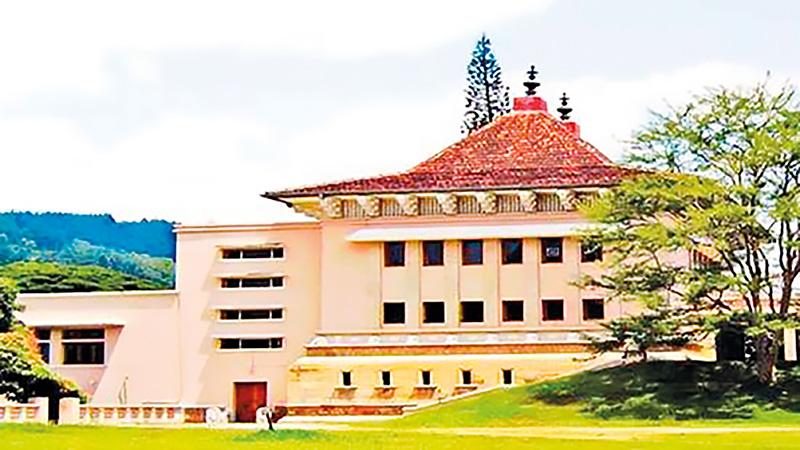
A recent discussion by former Environment Minister, Eng. Patali Champika Ranawaka on the Derana 360 programme has reignited an important national conversation on how Sri Lanka plans, builds and rebuilds in the face of recurring disasters.
His observations, delivered with characteristic clarity and logic, went beyond the immediate causes of recent calamities and focused sharply on long-term solutions—particularly the urgent need for smarter land use and vertical housing development.
Ranawaka’s proposal to introduce multistoried housing schemes in the Gannoruwa area, as a way of reducing pressure on environmentally sensitive and disaster-prone zones, resonated strongly with urban planners and environmentalists alike.
It also echoed ideas that have been quietly discussed within academic and conservation circles for years but rarely translated into policy.
One such voice is that of Professor Siril Wijesundara, Research Professor at the National Institute of Fundamental Studies (NIFS) and former Director General of the Royal Botanic Gardens, Peradeniya, who believes that disasters are often “less acts of nature and more outcomes of poor planning.”
“What we repeatedly see in Sri Lanka is not merely natural disasters, but planning failures,” Professor Wijesundara told The Island.
“Floods, landslides and environmental degradation are intensified because we continue to build horizontally, encroaching on wetlands, forest margins and river reservations, instead of thinking vertically and strategically.”
The former Director General notes that the University of Peradeniya itself offers a compelling case study of both the problem and the solution. The main campus, already densely built and ecologically sensitive, continues to absorb new faculties, hostels and administrative buildings, placing immense pressure on green spaces and drainage systems.
“The Peradeniya campus was designed with landscape harmony in mind,” he said. “But over time, ad-hoc construction has compromised that vision. If development continues in the same manner, the campus will lose not only its aesthetic value but also its ecological resilience.”
Professor Wijesundara supports the idea of reorganising the Rajawatte area—located away from the congested core of the university—as a future development zone. Rather than expanding inward and fragmenting remaining open spaces, he argues that Rajawatte can be planned as a well-designed extension, integrating academic, residential and service infrastructure in a controlled manner.
Crucially, he stresses that such reorganisation must go hand in hand with social responsibility, particularly towards minor staff currently living in the Rajawatte area.
“These workers are the backbone of the university. Any development plan must ensure their dignity and wellbeing,” he said. “Providing them with modern, safe and affordable multistoried housing—especially near the railway line close to the old USO premises—would be both humane and practical.”
According to Professor Wijesundara, housing complexes built near existing transport corridors would reduce daily commuting stress, minimise traffic within the campus, and free up valuable land for planned academic use.
More importantly, vertical housing would significantly reduce the university’s physical footprint.
Drawing parallels with Ranawaka’s Gannoruwa proposal, he emphasised that vertical development is no longer optional for Sri Lanka.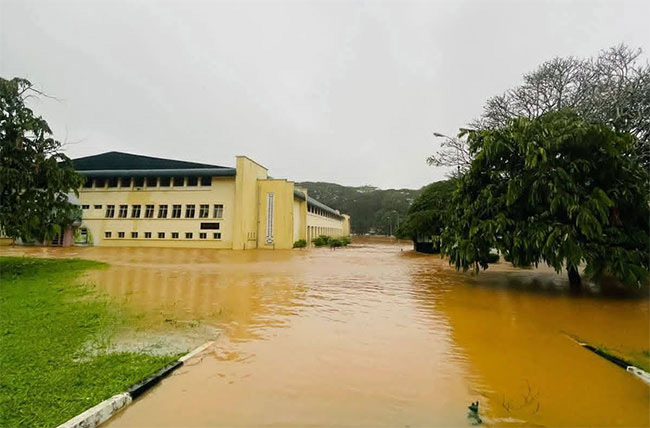
“We are a small island with a growing population and shrinking safe land,” he warned.
“If we continue to spread out instead of building up, disasters will become more frequent and more deadly. Vertical housing, when done properly, is environmentally sound, economically efficient and socially just.”
The veteran botanist also highlighted the often-ignored link between disaster vulnerability and the destruction of green buffers.
“Every time we clear a lowland, a wetland or a forest patch for construction, we remove nature’s shock absorbers,” he said.
“The Royal Botanic Gardens has survived floods for over a century precisely because surrounding landscapes once absorbed excess water. Urban planning must learn from such ecological wisdom.”
Professor Wijesundara believes that universities, as centres of knowledge, should lead by example.
“If an institution like Peradeniya cannot demonstrate sustainable planning, how can we expect cities to do so?” he asked. “This is an opportunity to show that development and conservation are not enemies, but partners.”
As climate-induced disasters intensify across the country, voices like his—and proposals such as those articulated by Patali Champika Ranawaka—underscore a simple but urgent truth: Sri Lanka’s future safety depends not only on disaster response, but on how and where we build today.
The challenge now lies with policymakers and planners to move beyond television studio discussions and academic warnings, and translate these ideas into concrete, people-centred action.
By Ifham Nizam ✍️
Features
Superstition – Major barrier to learning and social advancement

At the initial stage of my six-year involvement in uplifting society through skill-based initiatives, particularly by promoting handicraft work and teaching students to think creatively and independently, my efforts were partially jeopardized by deep-rooted superstition and resistance to rational learning.
Superstitions exerted a deeply adverse impact by encouraging unquestioned belief, fear, and blind conformity instead of reasoning and evidence-based understanding. In society, superstition often sustains harmful practices, social discrimination, exploitation by self-styled godmen, and resistance to scientific or social reforms, thereby weakening rational decision-making and slowing progress. When such beliefs penetrate the educational environment, students gradually lose the habit of asking “why” and “how,” accepting explanations based on fate, omens, or divine intervention rather than observation and logic.
Initially, learners became hesitant to challenge me despite my wrong interpretation of any law, less capable of evaluating information critically, and more vulnerable to misinformation and pseudoscience. As a result, genuine efforts towards social upliftment were obstructed, and the transformative power of education, which could empower individuals economically and intellectually, was weakened by fear-driven beliefs that stood in direct opposition to progress and rational thought. In many communities, illnesses are still attributed to evil spirits or curses rather than treated as medical conditions. I have witnessed educated people postponing important decisions, marriages, journeys, even hospital admissions, because an astrologer predicted an “inauspicious” time, showing how fear governs rational minds.
While teaching students science and mathematics, I have clearly observed how superstition acts as a hidden barrier to learning, critical thinking, and intellectual confidence. Many students come to the classroom already conditioned to believe that success or failure depends on luck, planetary positions, or divine favour rather than effort, practice, and understanding, which directly contradicts the scientific spirit. I have seen students hesitate to perform experiments or solve numerical problems on certain “inauspicious” days.
In mathematics, some students label themselves as “weak by birth”, which creates fear and anxiety even before attempting a problem, turning a subject of logic into a source of emotional stress. In science classes, explanations based on natural laws sometimes clash with supernatural beliefs, and students struggle to accept evidence because it challenges what they were taught at home or in society. This conflict confuses young minds and prevents them from fully trusting experimentation, data, and proof.
Worse still, superstition nurtures dependency; students wait for miracles instead of practising problem-solving, revision, and conceptual clarity. Over time, this mindset damages curiosity, reduces confidence, and limits innovation, making science and mathematics appear difficult, frightening, or irrelevant. Many science teachers themselves do not sufficiently emphasise the need to question or ignore such irrational beliefs and often remain limited to textbook facts and exam-oriented learning, leaving little space to challenge superstition directly. When teachers avoid discussing superstition, they unintentionally reinforce the idea that scientific reasoning and superstitious beliefs can coexist.
To overcome superstition and effectively impose critical thinking among students, I have inculcated the process to create a classroom culture where questioning was encouraged and fear of being “wrong” was removed. Students were taught how to think, not what to think, by consistently using the scientific method—observation, hypothesis, experimentation, evidence, and conclusion—in both science and mathematics lessons. I have deliberately challenged superstitious beliefs through simple demonstrations and hands-on experiments that allow students to see cause-and-effect relationships for themselves, helping them replace belief with proof.
Many so-called “tantrik shows” that appear supernatural can be clearly explained and exposed through basic scientific principles, making them powerful tools to fight superstition among students. For example, acts where a tantrik places a hand or tongue briefly in fire without injury rely on short contact time, moisture on the skin, or low heat transfer from alcohol-based flames rather than divine power.
“Miracles” like ash or oil repeatedly appearing from hands or idols involve concealment or simple physical and chemical tricks. When these tricks are demonstrated openly in classrooms or science programmes and followed by clear scientific explanations, students quickly realise how easily perception can be deceived and why evidence, experimentation, and critical questioning are far more reliable than blind belief.
Linking concepts to daily life, such as explaining probability to counter ideas of luck, or biology to explain illness instead of supernatural causes, makes rational explanations relatable and convincing.
Another unique example that I faced in my life is presented here. About 10 years ago, when I entered my new house but did not organise traditional rituals that many consider essential for peace and prosperity as my relatives believed that without them prosperity would be blocked. Later on, I could not utilise the entire space of my newly purchased house for earning money, largely because I chose not to perform certain rituals.
While this decision may have limited my financial gains to some extent, I do not consider it a failure in the true sense. I feel deeply satisfied that my son and daughter have received proper education and are now well settled in their employment, which, to me, is a far greater achievement than any ritual-driven expectation of wealth. My belief has always been that a house should not merely be a source of income or superstition-bound anxiety, but a space with social purpose.
Instead of rituals, I strongly feel that the unused portion of my house should be devoted to running tutorials for poor and underprivileged students, where knowledge, critical thinking, and self-reliance can be nurtured. This conviction gives me inner peace and reinforces my faith that education and service to society are more meaningful measures of success than material profit alone.
Though I have succeeded to some extent, this success has not been complete due to the persistent influence of superstition.
by Dr Debapriya Mukherjee
Former Senior Scientist
Central Pollution Control Board, India ✍️
Features
Race hate and the need to re-visit the ‘Clash of Civilizations’

 Australian Prime Minister Anthony Albanese has done very well to speak-up against and outlaw race hate in the immediate aftermath of the recent cold-blooded gunning down of several civilians on Australia’s Bondi Beach. The perpetrators of the violence are believed to be ardent practitioners of religious and race hate and it is commendable that the Australian authorities have lost no time in clearly and unambiguously stating their opposition to the dastardly crimes in question.
Australian Prime Minister Anthony Albanese has done very well to speak-up against and outlaw race hate in the immediate aftermath of the recent cold-blooded gunning down of several civilians on Australia’s Bondi Beach. The perpetrators of the violence are believed to be ardent practitioners of religious and race hate and it is commendable that the Australian authorities have lost no time in clearly and unambiguously stating their opposition to the dastardly crimes in question.
The Australian Prime Minister is on record as stating in this connection: ‘ New laws will target those who spread hate, division and radicalization. The Home Affairs Minister will also be given new powers to cancel or refuse visas for those who spread hate and a new taskforce will be set up to ensure the education system prevents, tackles and properly responds to antisemitism.’
It is this promptness and single-mindedness to defeat race hate and other forms of identity-based animosities that are expected of democratic governments in particular world wide. For example, is Sri Lanka’s NPP government willing to follow the Australian example? To put the record straight, no past governments of Sri Lanka initiated concrete measures to stamp out the evil of race hate as well but the present Sri Lankan government which has pledged to end ethnic animosities needs to think and act vastly differently. Democratic and progressive opinion in Sri Lanka is waiting expectantly for the NPP government’ s positive response; ideally based on the Australian precedent to end race hate.
Meanwhile, it is apt to remember that inasmuch as those forces of terrorism that target white communities world wide need to be put down their counterpart forces among extremist whites need to be defeated as well. There could be no double standards on this divisive question of quashing race and religious hate, among democratic governments.
The question is invariably bound up with the matter of expeditiously and swiftly advancing democratic development in divided societies. To the extent to which a body politic is genuinely democratized, to the same degree would identity based animosities be effectively managed and even resolved once and for all. To the extent to which a society is deprived of democratic governance, correctly understood, to the same extent would it experience unmanageable identity-bred violence.
This has been Sri Lanka’s situation and generally it could be stated that it is to the degree to which Sri Lankan citizens are genuinely constitutionally empowered that the issue of race hate in their midst would prove manageable. Accordingly, democratic development is the pressing need.
While the dramatic blood-letting on Bondi Beach ought to have driven home to observers and commentators of world politics that the international community is yet to make any concrete progress in the direction of laying the basis for an end to identity-based extremism, the event should also impress on all concerned quarters that continued failure to address the matters at hand could prove fatal. The fact of the matter is that identity-based extremism is very much alive and well and that it could strike devastatingly at a time and place of its choosing.
It is yet premature for the commentator to agree with US political scientist Samuel P. Huntingdon that a ‘Clash of Civilizations’ is upon the world but events such as the Bondi Beach terror and the continuing abduction of scores of school girls by IS-related outfits, for instance, in Northern Africa are concrete evidence of the continuing pervasive presence of identity-based extremism in the global South.
As a matter of great interest it needs mentioning that the crumbling of the Cold War in the West in the early nineties of the last century and the explosive emergence of identity-based violence world wide around that time essentially impelled Huntingdon to propound the hypothesis that the world was seeing the emergence of a ‘Clash of Civilizations’. Basically, the latter phrase implied that the Cold War was replaced by a West versus militant religious fundamentalism division or polarity world wide. Instead of the USSR and its satellites, the West, led by the US, had to now do battle with religion and race-based militant extremism, particularly ‘Islamic fundamentalist violence’ .
Things, of course, came to a head in this regard when the 9/11 calamity centred in New York occurred. The event seemed to be startling proof that the world was indeed faced with a ‘Clash of Civilizations’ that was not easily resolvable. It was a case of ‘Islamic militant fundamentalism’ facing the great bulwark, so to speak, of ‘ Western Civilization’ epitomized by the US and leaving it almost helpless.
However, it was too early to write off the US’ capability to respond, although it did not do so by the best means. Instead, it replied with military interventions, for example, in Iraq and Afghanistan, which moves have only earned for the religious fundamentalists more and more recruits.
Yet, it is too early to speak in terms of a ‘Clash of Civilizations’. Such a phenomenon could be spoken of if only the entirety of the Islamic world took up arms against the West. Clearly, this is not so because the majority of the adherents of Islam are peaceably inclined and want to coexist harmoniously with the rest of the world.
However, it is not too late for the US to stop religious fundamentalism in its tracks. It, for instance, could implement concrete measures to end the blood-letting in the Middle East. Of the first importance is to end the suffering of the Palestinians by keeping a tight leash on the Israeli Right and by making good its boast of rebuilding the Gaza swiftly.
Besides, the US needs to make it a priority aim to foster democratic development worldwide in collaboration with the rest of the West. Military expenditure and the arms race should be considered of secondary importance and the process of distributing development assistance in the South brought to the forefront of its global development agenda, if there is one.
If the fire-breathing religious demagogue’s influence is to be blunted worldwide, then, it is development, understood to mean equitable growth, that needs to be fostered and consolidated by the democratic world. In other words, the priority ought to be the empowerment of individuals and communities. Nothing short of the latter measures would help in ushering a more peaceful world.
-

 News4 days ago
News4 days agoMembers of Lankan Community in Washington D.C. donates to ‘Rebuilding Sri Lanka’ Flood Relief Fund
-

 News2 days ago
News2 days agoBritish MP calls on Foreign Secretary to expand sanction package against ‘Sri Lankan war criminals’
-

 Business6 days ago
Business6 days agoBrowns Investments sells luxury Maldivian resort for USD 57.5 mn.
-

 News5 days ago
News5 days agoAir quality deteriorating in Sri Lanka
-

 News5 days ago
News5 days agoCardinal urges govt. not to weaken key socio-cultural institutions
-

 Features6 days ago
Features6 days agoHatton Plantations and WNPS PLANT Launch 24 km Riparian Forest Corridor
-
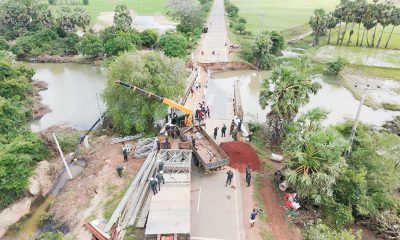
 Features6 days ago
Features6 days agoAnother Christmas, Another Disaster, Another Recovery Mountain to Climb
-

 Features4 days ago
Features4 days agoGeneral education reforms: What about language and ethnicity?

